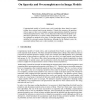Free Online Productivity Tools
i2Speak
i2Symbol
i2OCR
iTex2Img
iWeb2Print
iWeb2Shot
i2Type
iPdf2Split
iPdf2Merge
i2Bopomofo
i2Arabic
i2Style
i2Image
i2PDF
iLatex2Rtf
Sci2ools
NIPS
2007
2007
On Sparsity and Overcompleteness in Image Models
Computational models of visual cortex, and in particular those based on sparse coding, have enjoyed much recent attention. Despite this currency, the question of how sparse or how over-complete a sparse representation should be, has gone without principled answer. Here, we use Bayesian model-selection methods to address these questions for a sparse-coding model based on a Student-t prior. Having validated our methods on toy data, we find that natural images are indeed best modelled by extremely sparse distributions; although for the Student-t prior, the associated optimal basis size is only modestly over-complete.
| Added | 30 Oct 2010 |
| Updated | 30 Oct 2010 |
| Type | Conference |
| Year | 2007 |
| Where | NIPS |
| Authors | Pietro Berkes, Richard Turner, Maneesh Sahani |
Comments (0)

